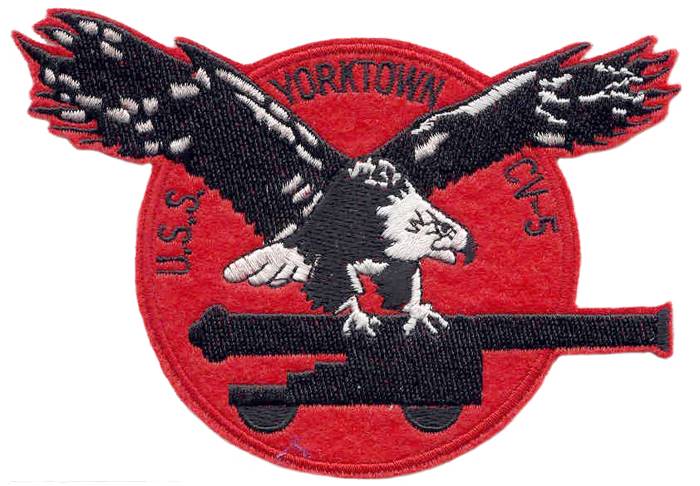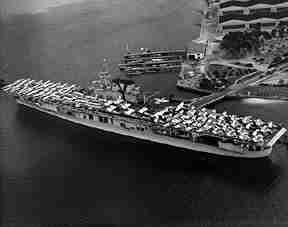UNITED STATES OF AMERICA NAVY
- PORTAEREI -
![]()
![]()
![]()
![]()
![]()
CLASSE ENTERPRISE
- AIRCRAFT CARRIER ENTERPRISE'S CLASS -
- PORTAEREI YORKTOWN (CV5) -
 - AIRCRAFT CARRIER YORKTOWN (CV5) -
- AIRCRAFT CARRIER YORKTOWN (CV5) -


STORIA DELLA CLASSE / HISTORY OF THE CLASS
Mentre la Ranger, di sole 14.500 tonnellate era ancora in costruzione, la Marina degli Stati Uniti riconobbe che questo dislocamento era insufficiente e stabilý che le nuove unita dovevano dislocare almeno 20.000 tonnellate.
Il programma navale del 1934 comprendeva le prime due di tali unitÓ: CV5 Yorktown e CV6 Enterprise.
La costruzione della Hornet fu autorizzata solo nel 1938. con queste unitÓ si fiss˛ il tipo di portaerei con isola sul lato destro e fumaiolo incorporato, abbandonando completamente la soluzione dei fumaioli abbattibili della Ranger. La linea esterna risentiva ancora dei precedenti concetti costruttivi in quanto il ponte di volo non costituiva parte integrante dello scafo, ma era montato su di esso, sostenuto da piloni con le solite finestrature laterali, di cui le due a pi\'f9 poppa fornite di grandi gru a bandiera.
Nella zona prodiera vi era una specie di castello che si elevava un interponte al di sopra del ponte aviorimessa. Il ponte di volo si estendeva quasi per tutta la lunghezza dello scafo; nel corso della guerra esso fu allungato e allargato raggiungendo le dimensioni di 250,06x34,73.
Come tutte le portaerei americane costruite prima della Essex (1945), questo ponte di volo era fatto con tavole di legno disposte nel senso trasversale e ed era munito di due barriere anti-vento abbattibili.
Questa fu la prima classe di unitÓ ad avere tre elevatori per trasportare gli aerei dal ponte di volo all'aviorimessa e viceversa: essi erano sistemati lungo l'asse della nave, uno nella zona prodiera, uno al centro all'altezza del l'isola e uno nella zona prodiera. L'aviorimessa aveva il ponte fatto con corazzette dello spessore di 76 mm. ed era munita di cinque grandi aperture sul lato destro e sei sul lato sinistro, attraverso le quali si potevano imbarcare materiali, rifornimenti e aerei completi. Era stato previsto di porre su tale ponte delle catapulte trasversali in corrispondenza delle aperture, ma tale sistemazione non fu mai realizzata. La corazzatura di murata era limitata alla zona centrale a livello del galleggiamento e aveva lo spessore di 101 mm. L'isola era occupata per circa metÓ della sua lunghezza dal fumaiolo: nella sua parte prodiera era costituita da una sovrastruttura a tre ponti. A proravia del fumaiolo vi era un albero tripode.
Gli 8 cannoni da 127 mm. Erano sistemati in postazioni singole due su ognuna delle quattro plancette esterne al ponte di volo ; durante la guerra il numero delle mitragliere fu aumentato di 40 armi da 40 mm. In dieci postazioni quadruple, anche esse a lato del ponte di volo. L'apparato motore era costituito da nove caldaie in un unico locale e da quattro gruppi di turbine in un altro locale: la velocitÓ di 34 nodi era superiore a quella di progetto.
While the Ranger, of sun 14.500 tons it was still in construction, the Marina of the United States recognized that this displacement was insufficient and established that the new united they had to displace at least 20.000 tonnellate. s
The 1934 naval program included the first two of such unities: CV5 Yorktown and CV6 Enterprise.
The construction of the Hornet was cleared only in 1938. with these unities it settled the type of aircraft carrier with island on the right side and incorporated chimney, abandoning completely the solution of the chimneys the Ranger's abbattibili. The external line still heard again some precedents constructive concepts in how much the bridge of flight didn't constitute integral part of the hull, but you/he/she was climbed on on it, sustained by pylons with the usual side finestratures, of which the two to pi \ 'f9 sucks you furnish of great crane to bandiera.
In the zone prodiera there was a kind of castle that an interponte raised him above the bridge hangar. The bridge of flight almost extended him for the whole length of the hull; during the war it had lengthened and widened reaching the dimensions of 250,06x34,73.
As all the American aircraft carriers built before Essex (1945), this bridge of flight was made with wood tables prepared in the transversal sense and and you/he/she was provided of two barriers anti-wind abbattibili.
This was the first class of unity to have three elevators to transport the airplanes from the bridge of flight to the hangar and vice versa: they was systematized along the axle of the ship, one in the zone prodiera, one to the center to the height of the the island and one in the zone prodiera. The hangar had the bridge done with corazzette of the thickness of 76 mms. and you/he/she was provided of five great openings on the right side and you are on the left side, through which you/they could be embarked material restocking and complete airplanes. You/he/she had been anticipated to set on such bridge of the transversal catapults in correspondence of the openings, but such setup was never realized. The corazzatura of bulwark was limited to the central zone to level of the galleggiamento and had the thickness of 101 mms. The island was busy for around halves its length from the chimney: in his/her part prodiera was constituted by a superstructure to three bridges. To proravia of the chimney there was a tree tripode.
The 8 guns from 127 mms. You/they were systematized in single postings two on each of the four external plancettes to the bridge of flight; during the war the number of the gunner was increased of 40 weapons by 40 mms. In ten quadruple postings, also them to side of the bridge of flight. The apparatus motor was constituted by nine boilers in an only place and from four groups of whirlwind in another place: the speed of 34 knots was superior to that of project.
PORTAEREI YORKTOWN CV5 / AIRCRAFT CARRIER YORKTOWN CV5
PORTAEREI NELLA STORIA / AIRCRAFT CARRIERS
NAVI DA GUERRA / WARSHIPS AND BATTLESHIPS